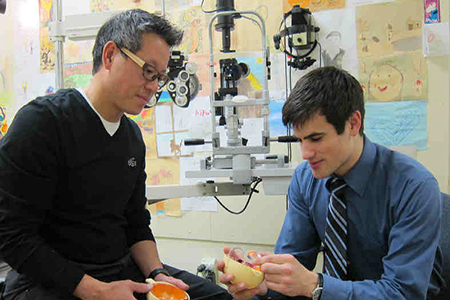Throughout history artists have made it their mission to inspire emotion elicit deep thought and creatively respond to the currents of their culture. From Jonathan Ive (lead designer of the iPhone iPod iPad and other Apple products) to da Vinci artists and designers have had a major role not only in creating aesthetically pleasing works but also products to improve our lives.
Maybe you have that same desire! Maybe you know you have an artistic or design talent but you aren’t sure whether you can make a career out of it. Of course there are no guarantees in life but the good news is a major and career in the arts can offer much more than you might have realized. Whether you prefer printmaking or computer animation painting with oils or graphic design an art institution or specialized program might be the next step for you. All you need is an eagerness to create and a strong commitment to developing an artistic vision.
AVENUES OF EXPRESSION
There are so many ways to express yourself artistically––and not just through traditional methods such as drawing fiber arts dance architecture and filmmaking (although these are all fantastic outlets!). There are also digital media arts video urban design animation comics and other 21st-century programs and technologies turning the creative world on its head.
Kristopher Jones, admissions officer at Kendall College of Art and Design (MI) says the purpose of traditional fine arts “is to communicate inspire convict inform comfort challenge stir [and] motivate an audience to consider and respond to what is presented in the artwork.” On the other hand applied arts can use a similar set of artistic skills but it is usually to create a product or design for a specific client or company.
How about other careers that might come of an art degree? Art educators art historians museum curators and gallery art installers are all worthy pursuits. Society needs innovative new fashion designers and creative people to design technological devices. Colleen Mulvey, associate director of admissions at San Francisco Art Institute (SFAI) says she has also noticed a trend toward connecting art and societal issues. “There’s urban planning psychology public art––how you bring your art practice out of the studio and into the urban environment,” she says.
Maggy Cuesta, dean of visual arts at New World School of the Arts (NWSA) in Florida says this year she has noticed a rise in the amount of art installations and performance-based art. However “the most important thing that is happening,” she adds “is that the mediums are becoming very interdisciplinary.”
Shari Fox, executive vice president of O’More College of Design (TN) echoes the benefits of using design skills in a variety of ways: “Design school graduates have learned to use design to communicate ideas and solve problems which can work to their advantage in a plethora of careers.”
DO YOUR HOMEWORK
If you feel like your interests skills and experiences would be a good fit for the arts the first step is to investigate the kinds of programs available and where they’re offered. Research is key! Ask your guidance counselor for insights on recommended programs. Talk to your art teacher or a trusted arts mentor in your community. Get insights from parents and friends. Pore over brochures catalogs and websites. See what kinds of financial aid the schools offer.
Also gather information about the reputations of each program either by searching online or by asking people who might know. Look at what each school’s strongest emphases are. Some might be strongest in photography others in sculpture and so on.
Schools like O’More College of Design emphasize interior design and fashion design while others focus on traditional arts. Ask how many graduates of each school are placed in jobs or creative roles after college.
Of course if possible visit the school(s) sit in on classes and talk to current art students about their experiences before making a decision.
“We encourage students to study their passion,” says Cuesta of NWSA. “We are here to develop their skills; they have to bring the desire and love for the arts with them.” Ed Newhall, director of admissions at Rhode Island School of Design (RISD) adds “Students who come to RISD know at a gut level they want to live and work creatively––as artists and designers and as innovators makers and problem solvers. They know that learning to bring ideas to life in the studio leads to amazing breakthroughs.”
HOW TO GET IN
Art schools and programs vary in how many students they accept; some are very selective and some are less so. Many consider both a student’s academic record and art portfolio as primary factors in admission.
Most schools look for a wide range of skills in different mediums in an applicant’s portfolio––such as drawing painting photography or sculpture. Others look for a special skill in a particular area or art expressing strong meaningful themes. Mulvey says SFAI typically wants to see 10 to 15 excellent portfolio examples. “What we really focus on is looking for a cohesive body of work that makes sense together,” she says. “Not just how those pieces connect together––the sequences of those images are really important too.”
Mulvey also encourages students to attend a National Portfolio Day; these are days in which students can bring their portfolios to a nearby campus to be evaluated by art professors or admissions officers. “We want them to see the way that the admissions counselors talk about their work,” she says.
Michael Hayes, admissions director at Lyme Academy College of Fine Arts (CT) says that while technical skills are important he also looks for students who are teachable. “He/she doesn’t have to be the best artist when applying but we have to see that grain of potential in their portfolio. We see potential in variety in your portfolio in risk-taking and in passion for your work. We obviously look for creativity—something different and inspiring but also we always want to see some drawing from direct observation.”
WHAT TO DO TODAY
There is plenty a passionate young artist can do to prepare to apply to an arts school or program––and it’s not just to take art classes and keep up your grades! Admissions officers observe that the strongest artists are often those who have already been focusing on their craft because they love doing it. Judith Aaron vice president for enrollment at Pratt Institute (NY) says students who are successful in the arts must be particularly hardworking and devoted to their ideas and their craft. “Art design writing and architecture are not good fields for students who are not self-motivated disciplined and ready to work hard,” she says “but they are extremely rewarding and fulfilling for the student ready to devote himself or herself to a creative life.”
Newhall of RISD says, “All prospective applicants are urged to follow a college preparatory program in secondary school taking courses in studio art and art history where possible.” Another idea is to apply to a pre-college arts program which is a session at a college or university (often during the summer) that helps high school students develop their art portfolios in an intense short period of time. It can give you a small taste of the rigor of college work that might be expected of you once you enter an art program. Plus it’s another great way to get early feedback from art instructors and professors.
Hayes adds that rather than a specific type of job/internship it’s important to be doing something for which you can demonstrate a passion. “If it’s art-related so much the better but that’s not key,” he says. “It’s the motivation behind why you’re doing the job/internship that’s important. That tells [the] admissions staff what sort of person you are which helps us determine whether you’re a good fit for us. Also we see a summer job/internship which is a volunteer position as a valuable experience.”
So if you have the artist dream burning inside you and you find a few programs that seem to be a good fit start taking the steps toward your creative future!
Jill Hicks is a writer and editor living in Missouri.



